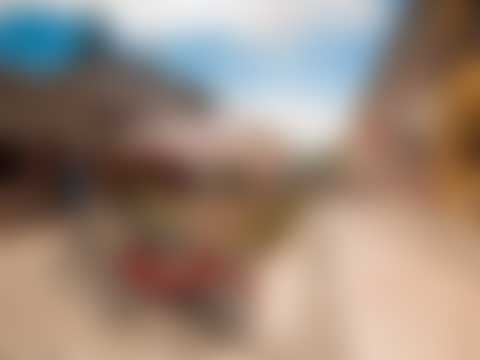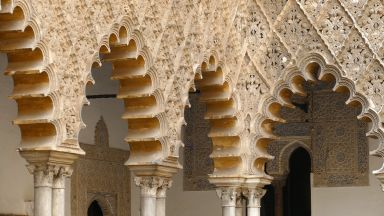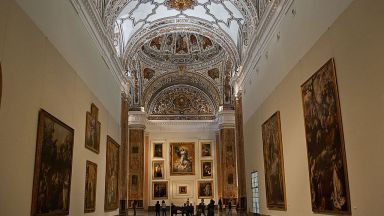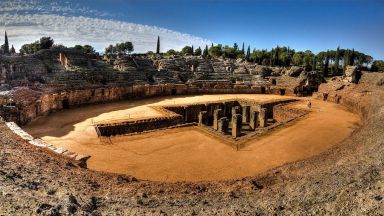Royal Alcázar Palace
Historic Building and Palace in Seville
The Royal Alcázars of Seville are a group of 14th century royal palaces in Seville, Spain. They are one of the city’s most enchanting, and most popular, historic monuments. The palaces showcase a mix of Moorish, Renaissance and Mudéjar architecture, with the latter being particularly notable in the Mudéjar Palace.
The upper floors of the Alcázar are the Spanish royal family’s Seville residence, making it Europe’s oldest continually used royal palace. Together with the Cathedral of Seville and General Archive of the Indies, they are recognized as UNESCO World Heritage site.
What to see at the Royal Alcázar Palace Seville
The Puerta de Léon – entrance of the Real Alcázar of Seville
You enter the monument through the Puerta de León, a door located on one side of the Cathedral. The door owes its name to a tile displaying a crowned lion that carries a cross with one paw and is stepping on a flag with the other. The maze of courtyards and gardens that you will find from here on is one of the most noteworthy features of the palace. Take your time to rejoice their beauty and the fusion of the different architectonic styles.
Gardens of Alcázar
The gardens of the palaces are city’s oldest, and feature ponds and fountains. The most famous and most pictured one is the Jardín de la Danza or the Garden of the Dance, because from here you can access the Baños de María Padilla, an underground chamber with Gothic vaults.
The Palacio Mudéjar also known as Palacio de Pedro I is the most famous palace in the Real Alcázar. A prominent feature is the Patio de las Doncellas or the Courtyard of the Maidens and the Patio de las Muñecas or the Courtyard of the Dolls.
These two patios are characterized by a combination of the Arab and Mudejar styles. The ‘Salón de Embajadores’ or’ Hall of the Ambassadors’, has a magnificent vault from 1427, and the Salón de Tapices, displays a collection of tapestries.
Among the breath-taking halls, you can’t miss out on the Pabellón de Carlos V or Pavilion of Charles V, where you will rejoice in a splendid collection of tapestries. And the Real Cuarto Alto is where the Bourbons left their mark, which you can see in the collections of personal objects and the decoration featured here.
History of the Real Alcázar of Seville
The construction work of the Real Alcázar started in 913 AD, under the Cordovan caliphate of Abderrahmán III an-Násir when the Umayyads built a Moorish fortress attached to the Roman city walls. Three centuries later, caliph Al-Mutamid had various palaces added to the original construction.
When the Christians conquered the city in the 13th century, King Alfonso X of Castile got the Gothic palace built, whereas, a century later, Peter I had a Mudejar palace added to the already-majestic architecture of the Alcazar, the most famous hall being the Hall of Ambassadors. In 1477, the Catholic Monarchs chose the Alcazar as their residence, and in 1526, the marriage between Charles V and Isabella of Portugal was celebrated in the Hall of Ambassadors (a curiosity: their honeymoon took place in Granada, where the emperor had the Palace of Charles V built inside the Alhambra).
The Alcázar became the official residence of the Spanish monarchy in 1823 until 1931 when the palace was claimed by politician Indalecio Prieto to be managed independently by the citizens.
The Royal Alcázar Palace appears in our Complete Guide to Visiting Seville!
Other names of Royal Alcázar Palace
The Royal Alcázar Palace has the following names: Reales Alcázares de Sevilla, Royal Alcázars of Seville, Alcázar of Seville.
This website uses affiliate links which may earn a commission at no additional cost to you!
Visiting Royal Alcázar Palace
From October to March: 9.30 am – 5 pm
From April to September: 9.30 am – 7 pm
Closed: January 1st and 6th, Good Friday and on December 25th
€11.50
Nearby Attractions
- Barrio Santa Cruz (0.2) km
Area in Seville - Real Fabrica de Tabacos (0.2) km
Historic Building in Seville - Hospital de los Venerables Sacerdotes (0.2) km
Gallery, Historic Building and Museum in Seville - Centro de Interpretacion Juderia de Sevilla (0.4) km
Museum in Seville - Tomb of Christopher Columbus (0.4) km
Cathedral and Tomb in Seville - Seville Cathedral (0.4) km
Cathedral, Historic Building and Mosque in Seville - Archivo General de Indias (0.4) km
Historic Building and Museum in Seville - El Giralda (0.4) km
Tower in Seville - Palacio de San Telmo (0.4) km
Historic Building and Palace in Seville - Casa Salinas de Seville (0.4) km
Palace in Seville



